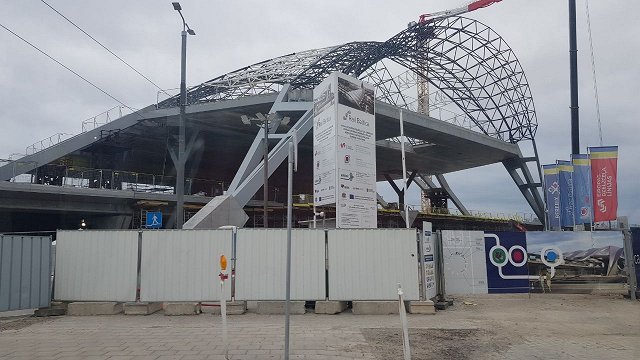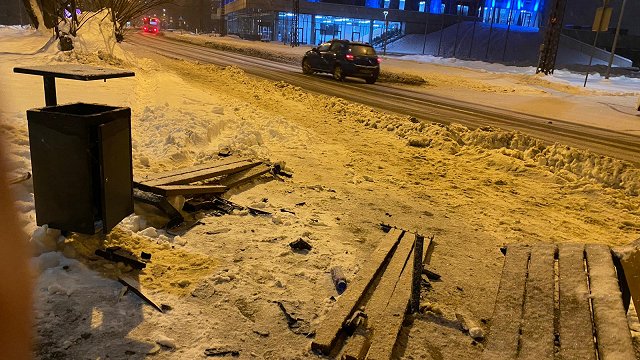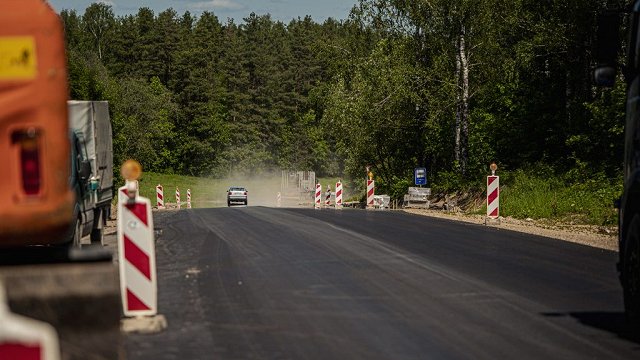The fact that the Rail Baltica route would cost more than the original €2 billion was already known to those involved five years ago, in 2019. RB Rail informed the Ministry of Transport about the amount of investment needed, according to a newly declassified information report on the implementation of Rail Baltica in Latvia.
Moreover, in 2021, RB Rail's estimates for the Latvian part of the project were already close to five billion, but no preventive action followed. At the time, De Facto was also aware of these estimates, but no official was ready to confirm them. In December 2021, in an interview with De Facto, then Transport Minister Tālis Linkaits (New Conservative Party) said: "It is too early to talk about the total cost at the moment, the design stage is still ongoing and then when the design of the whole route is finished, then we will know what the rough estimated prices ary during the construction process." He did not give any figure, not even a rough one.
According to the latest estimates, the entire project would cost Latvia €9.6 billion. But splitting it into sections and building a single track, not building regional stations and creating temporary solutions for some sections of Rīga, could come to €6.4 billion.
For the first phase alone, the Latvian government would have to decide how to find another €4 billion on top of the money potentially available.
Phasing is necessary because there is too little money and too little time. This week started with a presentation by RB Rail on the cost-benefit analysis - the net benefits of a fully completed Rail Baltica project over 80 years in all three Baltic States would be over €6 billion. That is, if the works are not delayed further.
Experts note that 76 risks have now been identified in the Rail Baltica project, 30 percent of them high or very high, with funding being the first.
After more than six months of delays, the Ministry of Transport was finally ready to put the report on the development of the project, which had been on the government's agenda for months, on the table. The discussions dragged on late into the evening and raised voices could be heard outside the closed-door session.
The ministers came out of the cabinet meeting convinced that the train route should pass through Rīga in the first phase.
Previously, a scenario where Riga was only partially included had been worked on for a long time. Asked by De Facto whether this discussion in the government should not have been held at the end of last year, when the report was first prepared, and whether half a year had been thrown away, Transport Minister Kaspars Briškens (Progressives) replied: "I would probably disagree that half a year has been thrown away. Obviously, given that the formal process in the Cabinet of Ministers is so extensive - I cannot remember when it has been from a public perspective at the moment, given the amount of information that ministers have read and assessed within their competencies..."
Briškens pointed out that the report had been considered by the cabinet when the other ministers were ready for it. However, the circulation of the document shows that it has been lying in the Ministry of Transport for much longer than, for example, in the Ministry of Finance, which had the most objections. After the first version of the information report was submitted for approval, the Ministry of Finance gave its opinion within three days, while the Ministry of Transport, for its part, updated it within 48 days. The document has been refined at similarly different speeds, albeit not for as long. In addition, the document does not necessarily need the agreement of all parties to be considered at the government level, and it was considered without it.
In the coming months, the Ministry of Transport, also in cooperation with others, has been tasked with several briefing reports, including on what to do next with the expensive Rīga stations. A financing plan for the high-speed train project should be prepared and submitted by the end of September.
But the question is whether a line through Riga can really be built in six years if there are no construction plans, no expropriation of property and no clean-up of land pollution. The companies involved have two weeks to respond.
"By June 30, this solution, all the risks, must be analyzed together with the joint venture, because in principle the infrastructure that has been built and the works and the risks that we had were already highlighted in this initial information report: the remediation works in the Vagonu Park, the individual properties that must be disposed of as a matter of urgency. Accordingly, we will put this offer together, we will also look from the railway timetable how we can maintain this original alignment. Because we have to cross quite a lot of track at Šķirotava, there is already a two-level ramp," said Ēriks Diļevs, Chairman of the Board of European Railway Lines.
Minister Briškens says that both the previously discussed scenario and the new one (through Rīga) would be similar in terms of cost. It is currently unknown what happens in such a scenario to the previously planned route, which after Salaspils crossed the Daugava, is marked as a military mobility route, and has received funding to build bridge abutments.
The State Audit Office report published this week also reveals fundamental and long-standing problems in the management of the Rail Baltica project. For example, there is a lack of principles for selecting the level at which changes, including those requiring large additional budget outlays, should be agreed. Not everything is addressed at the government level.
"There have also been changes in the people in charge in the ministry, and everyone who comes into this project has their own vision of how to implement this project, what to bring to the government, what not to bring to the government. Every decision is made based on some specific circumstances, the situation at the time, and the understanding. Why a number of issues were decided here at the Ministry and not brought to the Cabinet of Ministers, I cannot comment on, it is the decision of my colleagues," Ligita Austrupe, Acting State Secretary at the Ministry of Transport, told De Facto.
The State Audit Office report also shows that last year Minister Briškens had the section on indexation of construction costs for the Riga stations removed from the report to the government on Rail Baltica funding. Eight months later, the issue is back on the government's agenda, but already considerably more complex, and the project implementer EDzL is dealing with debts to contractors, which in theory also means the risk of insolvency.
"The Ministry of Transport just got a bill on the table. And in this case, I didn't just blindly pay a bill that someone threw on the table, but I wanted to make sure that all the procedures were actually followed, let's say," Briškens said.
Problems such as cost, delays, and lack of funding are similar in all three Baltic countries.
But, as the State Audit Office points out, the biggest difference is that neither Lithuania nor Estonia has the same secrecy over the project as Latvia.
"Information is more accessible to the public. I was very surprised when we did this study because we have all the IP, all the reports - restricted, nobody can know anything. For the Estonians and Lithuanians, well, I would not say that one hundred percent is open, but it is much more accessible, what the benefits are. First of all, the public knows what is going on, I know what I can expect and when and what I can count on. Plus, I think it is very valuable to make this information open, to listen to the views of the public, including experts," said Inese Kalvāne, Member of the Council of the State Audit Office.




























